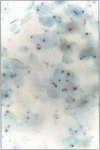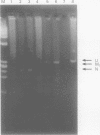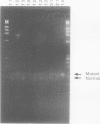Abstract
AIM: To examine the prevalence of genital type human papilloma virus (HPV) and mutations at codons 12, 13, and 61 in H, Ki, and N-ras in CIN III and early invasive squamous cell carcinomas of the cervix. METHODS: Prevalence of HPV was examined in 20 CIN III and 20 stage I and II cervical carcinomas, using non-isotopic in situ hybridisation (NISH) and solution phase polymerase chain reaction (PCR). In addition, mutations at codons 12, 13, and 61 were examined in H, Ki, and N-ras in these CIN III and early invasive squamous cell carcinomas, to assess the prevalence of ras gene point mutations and to define where in the pathobiology of squamous cell carcinoma such events occur. A non-isotopic PCR/RFLP assay was used to define these mutations. RESULTS: Of the 20 CIN IIIs examined, 19 contained HPV 16 DNA sequences by PCR and NISH. Dual infection was not uncovered. The 20 early (stage I and II) invasive squamous cell carcinomas showed predominant HPV 16 positivity (17/20), with one case HPV 18 positive, confirmed on PCR and NISH. Activating mutations were not identified in any of the CIN III cases. Only one stage I, HPV 16 positive carcinoma showed an activating mutation in H-ras codon 12, which was not present in adjacent normal ectocervical mucosa from the same patient. CONCLUSIONS: ras Activation does not appear to occur in conjunction with HPV infection, particularly of HPV 16 infected high grade cervical intraepithelial neoplasia, or to occur commonly in early cervical squamous cell carcinoma. The postulated model of HPV linked carcinogenesis suggests malfunctional control of viral transcription as a necessary component of neoplastic progression. It is also clear that host gene alterations are equally necessary for HPV linked carcinogenesis to occur.
Full text
PDF






Images in this article
Selected References
These references are in PubMed. This may not be the complete list of references from this article.
- Agnantis N. J., Spandidos D. A., Mahera H., Parissi P., Kakkanas A., Pintzas A., Papacharalampous N. X. Immunohistochemical study of ras oncogene expression in endometrial and cervical human lesions. Eur J Gynaecol Oncol. 1988;9(5):360–365. [PubMed] [Google Scholar]
- Barbacid M. ras genes. Annu Rev Biochem. 1987;56:779–827. doi: 10.1146/annurev.bi.56.070187.004023. [DOI] [PubMed] [Google Scholar]
- Bos J. L. The ras gene family and human carcinogenesis. Mutat Res. 1988 May;195(3):255–271. doi: 10.1016/0165-1110(88)90004-8. [DOI] [PubMed] [Google Scholar]
- Cichutek K., Duesberg P. H. Harvey ras genes transform without mutant codons, apparently activated by truncation of a 5' exon (exon -1). Proc Natl Acad Sci U S A. 1986 Apr;83(8):2340–2344. doi: 10.1073/pnas.83.8.2340. [DOI] [PMC free article] [PubMed] [Google Scholar]
- Enomoto T., Inoue M., Perantoni A. O., Terakawa N., Tanizawa O., Rice J. M. K-ras activation in neoplasms of the human female reproductive tract. Cancer Res. 1990 Oct 1;50(19):6139–6145. [PubMed] [Google Scholar]
- Gibbs J. B., Sigal I. S., Poe M., Scolnick E. M. Intrinsic GTPase activity distinguishes normal and oncogenic ras p21 molecules. Proc Natl Acad Sci U S A. 1984 Sep;81(18):5704–5708. doi: 10.1073/pnas.81.18.5704. [DOI] [PMC free article] [PubMed] [Google Scholar]
- Gilman A. G. G proteins and dual control of adenylate cyclase. Cell. 1984 Mar;36(3):577–579. doi: 10.1016/0092-8674(84)90336-2. [DOI] [PubMed] [Google Scholar]
- Grendys E. C., Jr, Barnes W. A., Weitzel J., Sparkowski J., Schlegel R. Identification of H, K, and N-ras point mutations in stage IB cervical carcinoma. Gynecol Oncol. 1997 May;65(2):343–347. doi: 10.1006/gyno.1997.4649. [DOI] [PubMed] [Google Scholar]
- Hiorns L. R., Scholefield J. H., Palmer J. G., Shepherd N. A., Kerr I. B. Ki-ras oncogene mutations in non-HPV-associated anal carcinoma. J Pathol. 1990 Jun;161(2):99–103. doi: 10.1002/path.1711610203. [DOI] [PubMed] [Google Scholar]
- Kitchener H. C. Recent developments in viruses and genetics in gynecologic cancer. Curr Opin Oncol. 1990 Oct;2(5):864–869. doi: 10.1097/00001622-199010000-00011. [DOI] [PubMed] [Google Scholar]
- Kumar R., Dunn L. L. Designed diagnostic restriction fragment length polymorphisms for the detection of point mutations in ras oncogenes. Oncogene Res. 1989;4(3):235–241. [PubMed] [Google Scholar]
- Manne V., Bekesi E., Kung H. F. Ha-ras proteins exhibit GTPase activity: point mutations that activate Ha-ras gene products result in decreased GTPase activity. Proc Natl Acad Sci U S A. 1985 Jan;82(2):376–380. doi: 10.1073/pnas.82.2.376. [DOI] [PMC free article] [PubMed] [Google Scholar]
- Matlashewski G., Schneider J., Banks L., Jones N., Murray A., Crawford L. Human papillomavirus type 16 DNA cooperates with activated ras in transforming primary cells. EMBO J. 1987 Jun;6(6):1741–1746. doi: 10.1002/j.1460-2075.1987.tb02426.x. [DOI] [PMC free article] [PubMed] [Google Scholar]
- Milici A., Blick M., Murphy E., Gutterman J. U. c-K-ras codon 12 GGT-CGT point mutation. An infrequent event in human lung cancer. Biochem Biophys Res Commun. 1986 Oct 30;140(2):699–705. doi: 10.1016/0006-291x(86)90788-6. [DOI] [PubMed] [Google Scholar]
- Mitsudomi T., Viallet J., Mulshine J. L., Linnoila R. I., Minna J. D., Gazdar A. F. Mutations of ras genes distinguish a subset of non-small-cell lung cancer cell lines from small-cell lung cancer cell lines. Oncogene. 1991 Aug;6(8):1353–1362. [PubMed] [Google Scholar]
- Pulciani S., Santos E., Long L. K., Sorrentino V., Barbacid M. ras gene Amplification and malignant transformation. Mol Cell Biol. 1985 Oct;5(10):2836–2841. doi: 10.1128/mcb.5.10.2836. [DOI] [PMC free article] [PubMed] [Google Scholar]
- Riou G., Barrois M., Sheng Z. M., Duvillard P., Lhomme C. Somatic deletions and mutations of c-Ha-ras gene in human cervical cancers. Oncogene. 1988 Sep;3(3):329–333. [PubMed] [Google Scholar]
- Rumsby G., Carter R. L., Gusterson B. A. Low incidence of ras oncogene activation in human squamous cell carcinomas. Br J Cancer. 1990 Mar;61(3):365–368. doi: 10.1038/bjc.1990.80. [DOI] [PMC free article] [PubMed] [Google Scholar]
- Van Le L., Stoerker J., Rinehart C. A., Fowler W. C. H-ras codon 12 mutation in cervical dysplasia. Gynecol Oncol. 1993 May;49(2):181–184. doi: 10.1006/gyno.1993.1104. [DOI] [PubMed] [Google Scholar]
- Victor T., Du Toit R., Jordaan A. M., Bester A. J., van Helden P. D. No evidence for point mutations in codons 12, 13, and 61 of the ras gene in a high-incidence area for esophageal and gastric cancers. Cancer Res. 1990 Aug 15;50(16):4911–4914. [PubMed] [Google Scholar]
- Walter M., Clark S. G., Levinson A. D. The oncogenic activation of human p21ras by a novel mechanism. Science. 1986 Aug 8;233(4764):649–652. doi: 10.1126/science.3487832. [DOI] [PubMed] [Google Scholar]
- Westaway D., Papkoff J., Moscovici C., Varmus H. E. Identification of a provirally activated c-Ha-ras oncogene in an avian nephroblastoma via a novel procedure: cDNA cloning of a chimaeric viral-host transcript. EMBO J. 1986 Feb;5(2):301–309. doi: 10.1002/j.1460-2075.1986.tb04213.x. [DOI] [PMC free article] [PubMed] [Google Scholar]
- van den Brule A. J., Snijders P. J., Gordijn R. L., Bleker O. P., Meijer C. J., Walboomers J. M. General primer-mediated polymerase chain reaction permits the detection of sequenced and still unsequenced human papillomavirus genotypes in cervical scrapes and carcinomas. Int J Cancer. 1990 Apr 15;45(4):644–649. doi: 10.1002/ijc.2910450412. [DOI] [PubMed] [Google Scholar]





